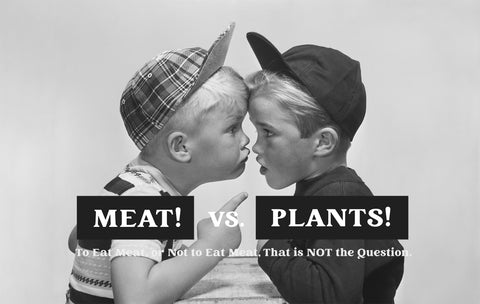What’s the Difference Between Organic and Regenerative Agriculture?
If you’re unsure about the difference between regenerative and organic agriculture, you're not alone. We all share the basic needs for nutritious food, clean air, water, and an overall healthy environment.
Organic and regenerative are simply two different approaches both aiming to achieve that. The former focuses on the finished product, what it does and does not contain. The ladder focuses on improving land health, which in turn generates a more nutrient-dense product.
Here’s a quick and easy breakdown, so you can make the most informed decisions for your family and the planet.
What is Regenerative Agriculture?
According to the dictionary, “Regenerative means able to or tending to regenerate—to regrow or be renewed or restored, especially after being damaged or lost. The act or process of regenerating is regeneration.”
Given the sky high rates of soil degradation, erosion, land conversion, habitat loss, deforestation, desertification, and pollution all contributing to climate change, the call of regeneration is one of hope.
As beautifully illustrated by botanist Robin Wall Kimmerer in “Braiding Sweetgrass”, humans can have a positive impact on planet Earth. By reevaluating our relationship to her, we can take actions to restore and repair damage, encouraging nature to heal at a pace she wouldn’t be able to achieve without us.
Regenerative agriculture is not a recipe or a prescription. It’s a conservation and rehabilitation approach to food and farming systems, taking into account the unique environmental, social, economic, cultural, and political contexts of each ranch and farm.
A highly localized and bottom-up approach, regenerative agriculture emphasizes producer-led problem-solving, empowering ranchers and farmers to become the experts of their own ecosystems.
Ensuring producers have the ability to make decisions on their land is important, because each is working within a different context than the other. Regenerative producers make decisions based on their different skills, goals, natural resources, and climate variability, taking into account that an otherwise beneficial practice applied at the wrong time or place can be harmful; there is no one-size-fits-all solution.
Considering working with living systems is complex and highly variable, regenerative agriculture is guided by a set of principles, philosophies, agricultural techniques, and holistic management frameworks. Some of which have even been used successfully by indigenous communities for thousands of years.
In addition to creating products free from harmful chemicals, pesticides, hormones, and antibiotics, regenerative agriculture regenerates topsoil, sequesters carbon, increases biodiversity, restores the water cycle, reduces waste, enhances ecosystem services, and produces the most nutrient-dense foods.
Studies and anecdotal evidence also demonstrate increased profitability and overall health and wellness for farmers and ranchers switching to a regenerative model.
Because regeneration is an ongoing process and not a destination, we need producers who are in deep connection with their land, able to read her cues, and anticipate her needs; we need people who understand ecology and the cosmic dance of energy.
Regenerative agriculture goes beyond organic because it goes beyond sustainability. It aims to not only restore what has been degraded or maintain what is, but to intentionally build more resilient and interconnected systems that continue to generate more life.
In essence regenerative means healthier lands, foods, people, and communities year after year. It means ranchers and farmers co-creating a more vibrant landscape with Mother Nature herself.
A Comparison: Regenerative Agriculture vs. Organic Agriculture
Organic is a labeling term which began in 1990 with the Organic Food Protection Act, passed in concern to the sharp increase of toxic chemicals, pesticides, hormones, heavy metals, and additives utilized in our industrial food production model.
To buy something organic means it was made without pesticides, synthetic fertilizers, genetically modified organisms, sewage sludge, or ionizing radiation. Foods labeled USDA Organic adhere to fixed definitions and requirements regulated by the federal government.
According to the USDA organic certification costs anywhere from a few hundred up to several thousand dollars. Expensive and inflexible, many smaller or mid-sized producers are unable to maintain certification.
Organic farms use the PAMS system (prevention, avoidance, monitoring and suppression) regarding disease, weeds, and pests. If this fails, ranchers and farmers contact their certifier requesting the use of a USDA approved naturally derived or synthetic pesticide, provided that it does not contaminate crops, water, or soil. Dive deeper into the USDA’s National List of Allowed and Prohibited Substances here.
Often monocultures, organic farms are more vulnerable to disease, pests, and crop loss than regenerative farms which adopt a polyculture model.
In terms of animal products, USDA organic requires animals to be raised in conditions which accommodate their natural behaviors, such as access to the outdoors, space for exercise, direct sunlight, shelter, etc. Animals are also hormone, antibiotic, and chemical free and fed a diet of 100% organic forage and feed, including grains, hay, and other agricultural products.
In comparing our verified regenerative ranches to organic standards, there is some overlap. We also don’t use toxic chemicals, pesticides, hormones, antibiotics, or additives, and treat our animals ethically.
However, the largest difference between regenerative and organic agriculture is that when you buy organic there is no proof or indication that the health of the land is improving. Without monitoring ecological outcomes, organic falls short of delivering us a food system which goes beyond sustainable. Sustaining the current system is not enough.

In redefining our relationship to our world, regenerative agriculture offers a holistic and deeply interconnected framework mimicking the intelligent design of Mother Nature herself.
REP Provisions Heals the Planet with Verified Regenerative Meats
We utilize the Savory Institute’s Ecological Outcome Verification™ protocol to monitor biodiversity, water filtration, soil carbon & health, as well as a host of other ecological indicators on our regenerative ranches.
By testing these key performance indicators, all of our products are verified regenerative by the Savory Institute’s Land to Market program, the first outcomes-based regenerative sourcing solution.
When you shop REP, you’re supporting small local ranchers who’ve proven they’re regenerating their land and leaving the planet healthier for future generations to come.
With no hormones, antibiotics, chemicals, pesticides, or additives, our 100% grass-fed & finished regenerative meats are nutritionally superior to grain-fed & grass-fed beef from non-regenerative farms. We tested it.



Comments (0)
There are no comments for this article. Be the first one to leave a message!